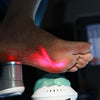Foot Tendonitis: Causes, Symptoms, Treatment, and Prevention

Foot tendinitis is a common orthopedic condition that affects the tendons in the foot, resulting in pain, discomfort, and decreased mobility. It can affect people of all ages and activity levels, including athletes and those who lead lives of inactivity. To help you better understand and manage foot tendonitis, we will look at its causes, symptoms, treatment options, and preventive measures in this comprehensive article.
Understanding Foot Tendonitis
Foot tendinitis is the inflammation or irritation of a tendon in the foot. It is also known as tendonitis. Tendons are strong, flexible bands of tissue that connect muscles to bones, allowing movement of the joints. When these tendons become inflamed or damaged, it can cause pain and discomfort, limiting your ability to walk and perform daily tasks.
Common Types
The foot can be affected by several types of tendinitis, the most common of which are:
Achilles Tendinitis: Inflammation of the Achilles tendon, which connects the calf muscles to the heel bone, causes this condition. It's common in runners and athletes.
Posterior Tibial Tendonitis: This condition affects the posterior tibial tendon, which runs along the inside of the ankle and supports the foot arch. It can result in flat feet or collapsed arches.
Peroneal Tendonitis: The peroneal tendons are responsible for ankle stability and balance. Lateral ankle pain can be caused by inflammation of these tendons.
Extensor Tendonitis: is an inflammation of the tendons on the top of the foot that is frequently caused by repetitive activities such as walking or running in ill-fitting shoes.
Causes
Foot tendonitis can be caused by a variety of factors, including:
Overuse or Repetitive Stress: Activities that put too much strain on the tendons, such as running, jumping, or dancing, can cause tendinitis.
Improper Footwear: Wearing shoes that do not provide adequate support or fit poorly can increase the risk of developing tendinitis.
Poor Foot Biomechanics: Foot structure abnormalities, such as flat feet or high arches, can change how forces are distributed, putting strain on specific tendons.
Aging: Tendons naturally weaken and become less flexible as we age, making older people more prone to tendonitis.
Injury: Injury to the foot can cause tendons to be damaged, resulting in inflammation and tendonitis.
Foot Tendonitis Symptoms
Foot tendonitis can cause the following symptoms:
● Pain and tenderness in the affected area, which is frequently exacerbated by movement or activity.
● Swelling and redness in the tendon's vicinity.
● The affected joint is stiff and difficult to move.
● Foot or ankle ache or burning sensation.
● Weakness in the affected tendon, which may result in gait abnormalities.
Foot Tendonitis Treatment Options
Foot tendonitis treatment aims to reduce pain, inflammation, and promote healing. Various approaches may be recommended depending on the severity of the condition:
Rest: Allowing the affected foot to heal by limiting or avoiding activities that aggravate symptoms.
Ice & Compression: Applying ice packs and wearing compression bandages can help reduce
inflammation and swelling.
Elevation: Raising the affected foot above the level of the heart can help to reduce swelling.
Orthotic Devices: Orthotic inserts, whether custom-made or over-the-counter, can improve foot support and alignment.
Physical therapy: This can help strengthen the muscles surrounding the affected tendon and improve flexibility.
Medication: Nonsteroidal anti-inflammatory drugs (NSAIDs) may be prescribed to relieve pain and inflammation.
Corticosteroid Injections: Corticosteroid injections may be used in severe cases to reduce inflammation and pain.
Immobilization: Wearing a brace, boot, or cast can limit movement and give the tendon time to heal.
Shockwave Therapy: This non-invasive treatment stimulates blood flow and promotes tissue healing by using shockwaves.
Surgery: In cases of severe or chronic tendinitis that does not respond to conservative treatments, surgery to repair or remove damaged tissue may be considered.
Foot Tendonitis Prevention
When it comes to foot tendonitis, prevention is often the best strategy. To reduce your risk, consider the following suggestions:
● Choose shoes that provide adequate support, cushioning, and stability for your foot type and activities.
● Avoid abrupt increases in activity intensity or duration, and incorporate proper warm-up and cool-down routines.
● Excess weight puts extra strain on the foot tendons, so keeping a healthy weight can help reduce the risk of tendinitis.
● Perform regular exercises to strengthen and stretch the muscles in your feet and ankles.
● Pay attention to early signs of discomfort or pain and seek treatment as soon as possible to prevent the condition from worsening.
Foot tendinitis is a common and often painful condition that can strike anyone at any time. Understanding the causes, symptoms, and treatments available is critical for managing and preventing its occurrence. You can reduce the impact of foot tendonitis on your daily life and maintain healthy, pain-free feet by taking preventive measures and seeking appropriate medical care when necessary. Always seek personalized advice and treatment options from a healthcare professional based on your specific condition.





